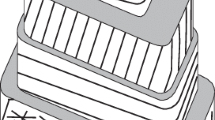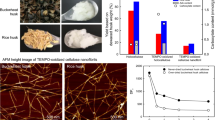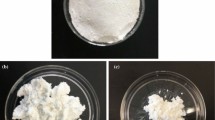Abstract
In order to elucidate the self assembly process of plant epicuticular waxes, and the molecular arrangement within the crystals, re-crystallisation of wax platelets was studied on biological and non-biological surfaces. Wax platelets were extracted from the leaf blades of wheat (Triticum aestivum L., c.v. ‘Naturastar’, Poaceae). Waxes were analysed by gas chromatography (GC) and mass spectrometry (MS). Octacosan-1-ol was found to be the most abundant chemical component of the wax mixture (66 m%) and also the determining compound for the shape of the wax platelets. The electron diffraction pattern showed that both the wax mixture and pure octacosan-1-ol are crystalline. The re-crystallisation of the natural wax mixture and the pure octacosan-1-ol were studied by scanning tunnelling microscopy (STM), atomic force microscopy (AFM), scanning electron microscopy (SEM), and transmission electron microscopy (TEM). Crystallisation of wheat waxes and pure octacosano-1-ol on the non polar highly ordered pyrolytic graphite (HOPG) led to the formation of platelet structures similar to those found on the plant surface. In contrast, irregular wax morphologies and flat lying plates were formed on glass, silicon, salt crystals (NaCl) and mica surfaces. Movement of wheat wax through isolated Convallaria majalis cuticles led to typical wax platelets of wheat, arranged in the complex patterns typical for C. majalis. STM of pure octacosan-1-ol monolayers on HOPG showed that the arrangement of the molecules strictly followed the hexagonal structure of the substrate crystal. Re-crystallisation of wheat waxes on non-polar crystalline HOPG substrate showed that technical surfaces could be used to generate microstructured, biomimetic surfaces. AFM and SEM studies proved that a template effect of the substrate determined the orientation of the re-grown crystals. These effects of the structure and polarity of the substrate on the morphology of the epicuticular waxes are relevant for understanding interactions between biological as well as technical surfaces and waxes.










Similar content being viewed by others
Abbreviations
- STM:
-
Scanning tunnelling microscopy
- AFM:
-
Atomic force microscopy
- SEM:
-
Scanning electron microscopy
- TEM:
-
Transmission electron microscopy
- TMS:
-
Trimethylsilyl
- HOPG:
-
Highly ordered pyrolytic graphite
- GC:
-
Gas chromatography
- MS:
-
Mass spectrometry
References
Baker EA (1982) Chemistry and morphology of plant epicuticular waxes. In: Cutler DF, Alvin KL, Price CE (eds) The plant cuticle. Academic, London, pp 139–166
Bargel H, Barthlott W, Koch K, Schreiber L, Neinhuis C (2004) Plant cuticles: multifunctional interfaces between plant and environment. In: Hemsley AR, Poole I (eds) Evolution of plant physiology. Academic, London, pp 171–194
Barthlott W (1990) Scanning electron microscopy of the epidermal surface in plants. In: Claugher D (ed) Scanning electron microscopy in taxonomy and functional morphology. Syst. Assoc. Spec. Vol. No. 41, Clarendon Press, pp 69–94
Barthlott W, Fröhlich D (1983) Mikromorphologie und Orientierungsmuster epicuticularer Wachs-Kristalloide: Ein neues systematisches Merkmal bei Monokotylen. Plant Syst Evol 142:171–185
Barthlott W, Neinhuis C (1997) Purity of the sacred lotus or escape from contamination in biological surfaces. Planta 202:1–7
Barthlott W, Neinhuis C, Cutler D, Ditsch F, Meusel I, Theisen I, Wilhelmi H (1998) Classification and terminology of plant epicuticular waxes. Bot J Linnean Soc 126:237–260
Barthlott W, Theisen I, Borsch T, Neinhuis C (2003) Epicuticular waxes and vascular plant systematics: integrating micromorphological and chemical data. In: Stuessy TF, Mayer V, Hörandl E (eds) Deep morphology: toward a renaissance of morphology in plant systematics. Reg Veg Gantner Verlag Ruggell/Liechtenstein 141, pp 189–206
Batra IP, Garcian N, Rohrer H, Salmink H, Stoll E, Ciraci S (1987) A study of graphite surface with STM and electronic-structure calculations. Surf Sci 181:126–138
Bianchi G (1995) Plant waxes. In: Hamilton RJ (ed) Waxes: Chemistry, molecular biology and functions. The Oily Press, Glasgow, pp 175–222
Bianchi G, Corbellini A (1977) Epicuticular wax of Triticum aestivum Demar 4. Phytochemistry 16:943–945
Bianchi G, Lupotto E, Corbellin M (1979) Composition of epicuticular waxes of Triticum aestivum demar 4 from different parts of the plant. Agrochimica 23:96–102
Buchholz S, Rabe JM (1992) Molecular imaging of alkanol monolayers on graphite. Angew Chem 31:189–191
Canet D, Rohr R, Chamel A, Guillain F (1996) Atomic force microscopy study of isolated ivy leaf cuticles observed directly and after embedding in Epon. New Phytol 134:571–577
Chambers TC, Ritchie IM, Booth MA (1975) Chemical models for plant wax morphogenesis. New Phytol 77:43–49
Cyr DM, Venkataraman B, Flynn GW (1996) STM investigations of organic molecules physisorbed at the liquid–solid interface. Chem Mater 8:1600–1615
De Feyter S, De Schryver FC (2003) Two-dimensional supramolecular self-assembly probed by scanning tunnelling microscopy. Chem Soc Rev 32:139–150
Dorset D (1999) Development of lamellar structures in natural waxes – an electron diffraction investigation. J Phys D-Appl Phys 32:1276–1280
Ensikat HJ, Barthlott W (1993) Liquid substitution: a versatile procedure for SEM specimen preparation of biological materials without drying or coating. J Microsc 172:195–203
Ensikat HJ, Neinhuis C, Barthlott W (2000) Direct access to plant epicuticular wax crystals by a new mechanical isolation method. Int J Plant Sci 161:143–148
Jeffree CE (1974) A method for recrystallizing selected components of plant epicuticular waxes as surfaces for the growth of microorganisms. Trans Brit Mycol Soc 63:626–628
Jeffree CE (1996) Structure and ontogeny of plant cuticles. In: Kerstiens G (ed) Plant cuticles: an integrated functional approach. BIOS Scientific Pub, Oxford, pp 33–82
Jeffree CE, Baker EA, Holloway PJ (1975) Ultrastructure and recrystallization of plant epicuticular waxes. New Phytol 75:539–549
Jeffree CE, Baker EA, Holloway PJ (1976) Origins of the fine structure of plant epicuticular waxes. In: Dickinson CH and Preece TF (eds) Microbiol aerial plant surf. Academic, London, pp 119–158
Jetter R, Riederer M (1994) Epicuticular crystals of nonacosan-10-ol: In-vitro reconstitution and factors influencing crystal habits. Planta 195:257–270
Jetter R, Riederer M (1995) In vitro reconstitution of epicuticular wax crystals: formation of tubular aggregates by long chain secondary alkendiols. Bot Acta 108:111–120
Jetter R, Schäffer S (2001) Chemical composition of the Prunus laurocerasus leaf surface. Dynamic changes of the epicuticular wax film during leaf development. Plant Physiol 126:1725–1737
Koch K, Neinhuis C, Ensikat HJ, Barthlott W (2004) Self assembly of epicuticular waxes on plant surfaces investigated by Atomic Force Microscopy (AFM). J Exp Bot 55:711–718
Kolattukudy PE (1980) Cutin, suberin, and waxes. In: Stumpf PK (ed) Lipids: structure and function. Academic, London, pp 571–646
Kolattukudy PE (1996) Biosynthetic pathways of cutin and waxes. In: Kerstiens G (ed) Plant cuticles an integrated functional appraoch. Bios Scientific, Oxford, pp 83–108
Kolattukudy PE (2001) Polyesters in higher plants. In Scheper T (ed) Biochemical engineering/biotechnology. Springer, Berlin Heidelberg New York, pp 4–49
Kunst L, Samuels AS (2003) Biosynthesis and secretion of plant cuticular wax. Prog in Lipid Res 42:51–80
Le Poulennec C, Cousty J, Xie ZX, Miokowski C (2000) Self organisation of physisorbed secondary alcohol molecules on a graphite surface. Surface Sci 448:93–100
Matas AJ, MJ Sanz, Heredia A (2003) Studies on the structure of plant wax nonacosan-10-ol, the main component of epicuticular wax conifers. Int J Biol Macromol 33:31–35
Meusel I, Neinhuis C, Markstädter K, Barthlott W (1999) Ultrastructure, chemical composition and recrystallization of epicuticular waxes: transversely ridged rodlets. Can J Bot 77:706–720
Meusel I, Barthlott W, Kutzke H, Barbier B (2000) Crystallographic studies of plant waxes. Powder Diffract 15:123–129
Neinhuis C, Koch K, Barthlott W (2001) Movement and regeneration of epicuticular waxes through plant cuticles. Planta 213:427–434
Rabe JP, Buchholz S (1991) Commensurability and mobility in 2-dimensional molecular patterns on graphite. Science 253:424–427
Reynhardt EC, Riederer M (1994) Structures and molecular dynamics of plant waxes. II. Cuticular waxes from leaves of Fagus sylvatica L. and Hordeum vulgare L. Eur Biophys J 23:59–70
Schönherr J, Riederer M (1986) Plant cuticles sorb lipophilic compounds during enzymatic isolation. Plant Cell Environ 9:456–466
Schreiber L, Kirsch T, Riederer M (1996) Diffusion through cuticles: principles and models. In: Kerstiens G (ed) Plant cuticles—an integrated functional approach. BIOS Sci Pub Ltd, Oxford, pp 109–119
Stevens JF, Hart H, Wollenweber E (1995) The systematic and evolutionary significance of exudate flavonoids in Aeonium. Phytochemistry 39:805–813
Truskett N van, Stebe KJ (2003) Influence of surfactants on an evaporating drop: fluorescence images and particle deposition paterns. Langmuir 19:8271–8279
Tulloch AP (1973) Composition of leaf surface waxes of Triticum species: variation with age and tissue. Phytochemistry 12:2225–2232
Tulloch AP, Bernard R, Hoffmann L (1980) A survey of epicuticular waxes among genera of Triticeae. 2. Chemistry. Can J Bot 58:2602–2615
Venkataraman B, Breen JJ, Flynn GW (1995) Scanning-tunneling-microscopy studies of solvent effects on the adsorbtion and mobility of triacontane triacontanol molecules adsorbed on graphite. J Phys Chem 99:6608–6619
Vogg G, Fischer S, Leide J, Emmanuel E, Jetter R, Levy AA, Riederer M (2004) Tomato fruit cuticular waxes and their effects on transpiration barrier properties: functional characterization of a mutant deficient in a very-long-chain fatty acid beta-ketoacyl-CoA synthase. J Exp Bot 55:1401–1410
Walton TJ (1990) Waxes, cutin and suberin. In: Harwood JL, Bowyer JR (eds) Lipids, membranes and aspects of photobiology. Academic, London, pp 105–158
von Wettstein-Knowles P (1971) The molecular phenotypes of the eceriferum mutants. In: Nilan RA (ed) Barley genetics. 2nd edn. Washington State Univ Press, Pullman, WA, pp 146–193
Wilms M, Kruft M, Bermes G, Wandelt K (1999) A new and sophisticated electrochemical STM design for the investigation of potentiodynamic processes. Rev Sci Instrum 70:36–41
Zeier J, Schreiber L (1997) Chemical composition of hypodermal and endodermal cell walls and xylem vessels isolated from Clivia miniata: identification of the biopolymers lignin and suberin. Plant Phys 113:1223–1231
Acknowledgements
We thank the Deutsche Forschungs Gemeinschaft, the Scientific Research-Flanders and the University of Bonn for the financial support of our research and the Physikalisch-Technische Bundesanstalt Braunschweig (Germany) for providing the standard normal for the AFM calibration, L. Schreiber and A. Dommisse (University of Bonn) for assistance in wax analysis, H.J. Ensikat for TEM analysis, the Institute for Organic Agriculture (University of Bonn) for providing the wheat seeds, and the reviewers for their helpful comments.
Author information
Authors and Affiliations
Corresponding author
Rights and permissions
About this article
Cite this article
Koch, K., Barthlott, W., Koch, S. et al. Structural analysis of wheat wax (Triticum aestivum, c.v. ‘Naturastar’ L.): from the molecular level to three dimensional crystals. Planta 223, 258–270 (2006). https://doi.org/10.1007/s00425-005-0081-3
Received:
Accepted:
Published:
Issue Date:
DOI: https://doi.org/10.1007/s00425-005-0081-3




